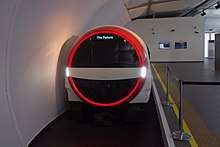New Tube for London
New Tube for London (NTfL), also known as the Deep Tube Upgrade Programme,[1] is a programme to introduce 250 new trains and signalling on several London Underground deep-tube lines between 2024 and 2033. The fully automated trains would increase capacity on the Piccadilly, Central, Waterloo & City and Bakerloo lines.
Deep Tube Upgrade Programme

The Deep Tube Upgrade Programme (DTUP) originally covered the replacement of the trains and signalling on the Bakerloo and Piccadilly lines; it had been expanded to cover the eventual replacement of 1992 Stock that serves the Central and Waterloo & City lines. The EVO tube concept design, a lighter articulated train with walk-through cars, was introduced early in 2011.[2] Siemens presented a response in 2011, a design with the weight reduced by 30 tonnes (29.5 long tons; 33.1 short tons) and energy consumption reduced by 17 per cent, thus generating less heat to be dispersed in the tunnels. The trains would have a lower floor and 11 per cent higher passenger capacity than the current tube trains.[3] Siemens presented a mock-up of its Inspiro design at The Crystal between October 2013 and January 2014.[4]
New Tube for London
In early 2014 the Bakerloo, Piccadilly, Central and Waterloo & City line rolling stock replacement project was renamed New Tube for London (NTfL) and moved from its feasibility stage to the design and specification stage. The study had shown that for new generation trains and re-signalling:
- Piccadilly line capacity could be increased by 60% with 33 trains per hour at peak times by 2025.
- Central line capacity increased by 25% with 33 trains per hour at peak times by 2030.
- Waterloo & City line capacity increased by 50% by 2032, after the track at Waterloo station was remodelled.
- Bakerloo line capacity could be increased by 25% with 27 trains per hour at peak times by 2033.
The project is estimated to cost £16.42 billion (£9.86 bn at 2013 prices). A notice was published on 28 February 2014 in the Official Journal of the European Union asking for expressions of interest in building the trains.[5][6] On 9 October 2014 Transport for London (TfL) published a shortlist of those (Alstom, Siemens, Hitachi, CAF and Bombardier) who had expressed an interest in supplying 250 trains for between £1.0 billion and £2.5 billion; on the same day opened an exhibition with a design by PriestmanGoode.[7][8] The fully automated trains may be able to run without drivers,[9] but the ASLEF and RMT trade unions that represent the drivers strongly oppose this, saying it would affect safety.[10] The invitation to tender for the trains was issued in January 2016[5][6] with the first train to run on the Piccadilly line in 2023.[11]
Siemens Mobility's Inspiro design was selected in June 2018 for the Piccadilly line stock in a £1.5 billion contract for 94 trains that are to be assembled in Goole.[12][13] In July 2018, the award was challenged in the High Court by the Hitachi/Bombardier joint consortium.[14] The challenge was unsuccessful; Siemens was awarded the contract in November, with deliveries to begin in 2023 and an entry into service in 2024. As of August 2020, the plan has been changed as only the Piccadilly line is scheduled to get the new trains with no new signalling due to budget restrictions. This is linked to a drop in fare revenue because of the COVID-19 pandemic.[15]
See also
- New Routemaster (formerly New Bus for London), flagship bus project for routes served in Central London.
References
- "Siemens Mobility Limited to be awarded TfL contract to design and manufacture a new generation of Tube trains". Transport for London. Retrieved 16 June 2018.
- Connor, Piers (January 2013). "Deep tube transformation". Modern Railways. pp. 44–47.
- "Siemens unveils London Underground concept train". Railway Gazette International. London. 20 June 2011.
- "Siemens unveils proposal for future London Underground train". Railway Gazette International. 4 October 2013. Retrieved 11 October 2013.
- "New Tube for London Programme" (PDF). Board Minutes. Transport for London. 5 February 2014. Retrieved 3 April 2014.
- "New Tube for London Programme". Railway Gazette International. 28 February 2014. Retrieved 3 April 2014.
- "Design for the 'New Tube for London' revealed" (Press release). TfL. 9 October 2014. Retrieved 9 October 2014.
- "New Tube for London Programme". BBC News. 9 October 2014. Retrieved 9 October 2014.
- "TfL prepares for driverless tube". Railnews. 28 February 2014. Retrieved 3 April 2014.
- "Driverless Tube trains: Unions vow 'war' over plan". BBC News. 28 February 2014. Retrieved 3 April 2014.
- "New Tube for London ITT delayed until December 2015".
- "East Yorkshire factory wins £1.5bn Tube train deal". BBC News. 15 June 2018. Retrieved 15 June 2018.
- Siemens to supply London Underground deep tube fleet Metro Report International 15 June 2018
- "Bombardier and Hitachi file high court papers over London Underground contract". International Railway Journal. 24 July 2018. Retrieved 24 July 2018.
- "Siemens signs £1·5bn London Underground train contract". Metro Report International. 20 November 2018. Retrieved 21 November 2018.
- "New Tube for London Feasibility Report October 2014" (PDF). tfl.gov.uk. Transport for London. October 2014. Retrieved 12 December 2016.
External links
| Wikimedia Commons has media related to New Tube for London. |